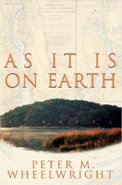Firstly, a shout out: to Mark Mathew Braunstein whose photograph of Mamacoke Island graces the cover of As It Is On Earth, and to Andy Carpenter who found the photo, and then designed it into AIIOE’s lovely book jacket.
Mamacoke Island plays a big role in the story. Its more than a place; its a character. It too has been caught in the turbulence of the river and the Age of Discovery. And like other characters in the book, it has a name, and like the island itself, names weather…
“The original colonial hamlet of Mamacoke is only a memory and a postal address. Left behind from its disappearance are a handful of weathered homes, hard bit fishermen, and a silted-in salt marsh that arcs around a small cove to the high wooded dome of Mamacoke Island rising out of the Thames. The first settlement took its name from the forty-acre island, but it’s been more than two hundred years since Mamacoke Island was surrounded by water. While the meaning of its Indian name was slowly eroding from memory, the soils from distant watersheds were building up the salt-marsh isthmus that would bind the island back to the mainland. ‘Mamacoke…Island’ – neither word makes much sense any longer, but everyone seems to know what they’re referring to.”
I suppose the point is that the simplicity of a name belies its complex genealogy and layers of meanings. Yet, somehow we always know what we’re talking about. As Taylor says: “…just secret codes. Shorthand for hidden histories. Great complex events stretching across vast reaches of time, bundled up in a word, a small single breath of air used to name it for one another.”








